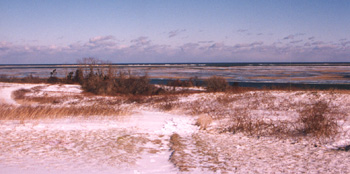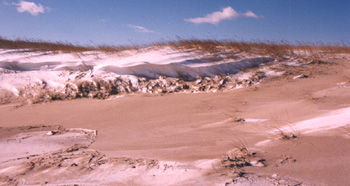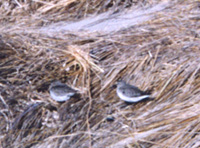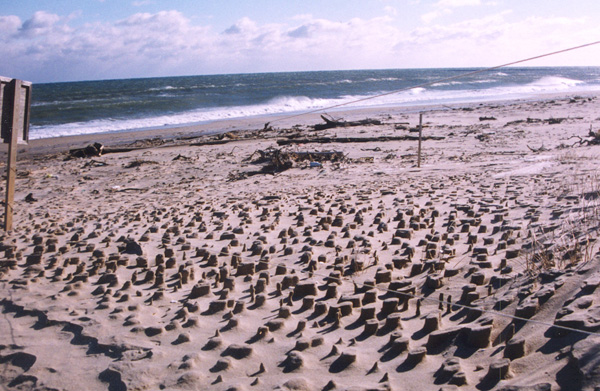|

Coast
Guard Beach in Eastham during the dead of winter. (Photos by Don Wilding)
A
deep freeze day at the beach
There was no doubt of what I wanted to do when I rose on the day of
Jan. 22 to temperatures of two below zero, with 40 mile-per-hour wind
gusts making the air feel like 45 below zero.
|
"What
a great day to go to the beach!" I thought, shivering as
I crawled out of bed.
Mind you, I didn't have just any beach in mind. There was only
one place I was heading to, and that was Coast Guard Beach in
Eastham, Mass., where writer/naturalist Henry Beston gathered
the material for what became his literary classic "The Outermost
House."
Beston wasn't
one of those beach bums with the
|
 Don
by the Sea
Don
by the Sea
By Don Wilding |
|
suntan oil, the
blanket, the umbrella, the cooler full of beer and the blaring radio.
No, he had built a house on the Eastham barrier beach in the 1920s so
that he could experience, firsthand, a year of life on the Great Beach
of Cape Cod. Whether it was bird migrations, shipwrecks, severe weather
conditions, or the roar of the sea outside his door, he merely wanted
to experience what Eastham had to offer.
I had been to Eastham
in many different kinds of weather -- rain, extreme heat, high winds
-- but never felt the chill of winter there. Wrapped in endless layers
of coats and camera draped about my neck, the idea of seeing the barrier
beach following the passing of a winter storm intrigued me. The Great
Blizzard of 1978, considered to be one of the most destructive Nor'easters
of all time, claimed Henry's little house on the beach and wiped out
much of what was another world to many people. What little was left
was feeling nature's strength once again.
|

View
of Nauset Spit and Marsh from Fort Hill.
|
Eastham
had been hit hard by snow over the past week. The storm, which dumped
only 3-5 inches of snow over the mainland and many other parts of
the Cape, was more generous in terms of precipitation here. Eastham
received 10 inches from the storm, which was piled up over the six
inches the town had received in a |
severe local snow
squall earlier in the week.
Most of the storm's power was out over the Atlantic, prompting longtime
Boston TV meteorologist and Eastham resident Bob Copeland to tell the
Cape Cod Times, "If the storm had tracked another 100 miles to
the west, we would be up to our ears in snow."
| The
storm still did its share of damage to the barrier beach, which
is gradually disappearing into the sea. One day, it will be gone
-- and so will many of the high-priced homes on the edge of Nauset
Marsh. A stretch of the southernmost tip of the Spit, about 150
yards or so, was flatter and more narrow than ever. The beach was
cluttered with broken tree limbs and anything else the sea wanted
to deposit there. In many areas, streams of ice ran from the ocean
to the marsh, which was mostly frozen over. |

Broken
tree limbs and other debris clutter Coast Guard Beach.
|
The Cape Cod Times
had reported that morning that the ocean did indeed overun the barrier
beaches, claiming some 20 feet of beach front from Nauset Beach in Orleans.
Walking Coast Guard Beach at high tide, it appeared that the Eastham
side had received similar treatment.
In the storm's wake, the Arctic Express powered its way over the Cape,
delivering monstrous wind gusts over Nauset Marsh and on to the beach.
Beston wrote of the severity of the northwest winds here, and I wasn't
about to dispute it. Here I was, dressed like I should be in ski country,
and I was on the beach -- facing weather conditions straight out of
Alaska. All those people who cluttered the beach here on that 95-degree
day in July -- where were they now?
The wind was relentless -- in fact, I found myself losing my balance
on several occasions. This kept me from walking near the water line,
where the ground was already a bit slick. One good gust could send me
tumbling into the waves -- an appealing thought for that day in July
(or even September or some days in early October), but certainly not
now. I had to chuckle when, leaving the beach later on, I came across
a man and his wife who jokingly inquired, "How's the water?"
In his book "The House on Nauset Marsh," I found Wyman Richardson's
words to ring true when he wrote "A nor'wester is a fighting man's
wind. It blows clean and strong. It knows the rules and plays the game.
It may lick you in a fair fight, but at least you know what you are
dealing with."
|

Sand and
snow design the dunes on a winter's day.
|
Nature's
efforts over the past week had presented fabulous photographic opportunities,
but the Arctic conditions presented a problem -- the air was so
cold that, after one or two shots, my camera's shutter froze. I
would have to keep it tucked inside my coat just to keep it working. |
Moving down the
beach, the water line was near some of the few small dunes that remained.
Sea grass and other items were strewn everywhere, giving what was either
saunderlings or dunlius small, temporary shelters from the northwesterly
gales and the double-digit sub-zero wind chills.
These and many other seam birds are the grittiest creatures on the Cape
-- come hell or high water, the Spit is still their home. It's no wonder
the gulls are always leaving their calling card on the hats of summer
tourists.
|
Beston noted
in his "Midwinter" chapter that, during this time of
year, "nothing remained of the insect world." The waterfowl
seemed to be the only life remaining out here. I had hoped to
spot a few seals (as I had during the summer), but it seemed that
even they had better places to be on a day like this.
In his chapter
"The Headlong Wave," Beston takes note of how the tops
of the breakers are sheared off during northwesterly gales. That
was the case here, as waves that were undoubtedly pounding the
beach one day earlier were being pushed around like a small child
trying to fight the class bully.
|

What
are either saunderlings or dunlius take shelter from the cold
gales under sea grass washed ashore on Coast Guard Beach.
|
The storm surge
had wiped out most of the snow on the beach, but it was still mixed
in with the sand on the dunes. It's worth the effort to come out here
as winter rages over the beach -- no human being is capable of producing
artwork like this.
With the wind at my back, the walk down the beach was relatively easy
-- it was getting back that was tough. I covered the entire Spit in
a little over an hour and a half, but the walk back was, without a doubt,
no easy task. Even though I was wrapped up tight like the ever-insightful
weather man had to told me to do, I was still feeling some of the chill
of this deep freeze.
Throughout the walk, I did not encounter a soul until my return to the
beach in front of the Coast Guard Station, where a couple was getting
a camera out of the backpack. "Good luck," I thought to myself.
There were a few more folks on the beach and outside the Coast Guard
Station area, which made me realize I wasn't the only one who might
be considered just a bit unusual.
Richardson noted in "House on Nauset Marsh" that, during a
rainstorm with northeasterly gales in April, "anyone with any sense
would 'hole in,' and spend the day on household tasks, or read, or play
cribbage.
"Instead of doing this," Richardson goes on, "we are
likely for some strange reason to take the car and drive to the Coast
Guard Station."
The same could be said for a bitterly cold nor'wester in the middle
of January. Sure, it might be an unusual day to spend at the beach --
but as Beston, Richardson and so many other Cape Cod writers will attest,
these types of days at the beach are usually the best kind.

Castles
in the sand, courtesy of the ocean's work at the base of the dunes in
front of the Coast Guard Station.
Originally
filed Jan. 22, 2000
Don
by the Sea archives
|







